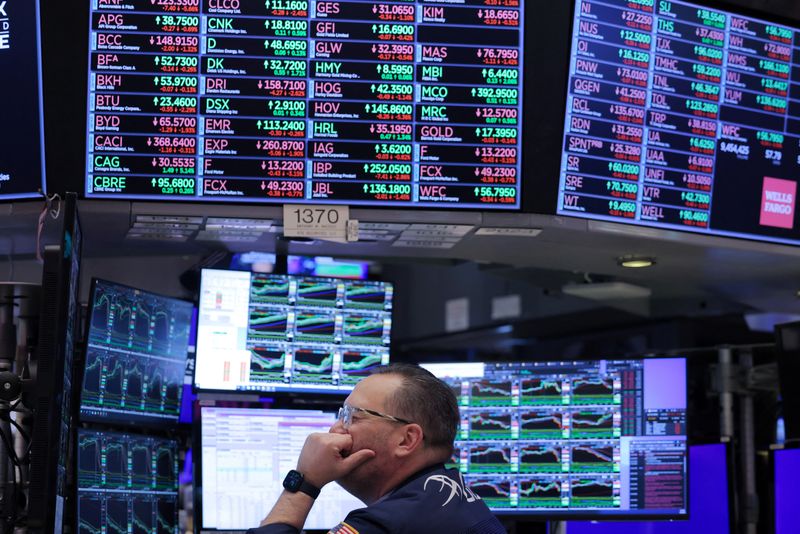Bill Gross warns on gold momentum as regional bank stocks tumble
Investing.com - U.S. stock futures point lower on Monday ahead of the start of a critical week that is tipped to include much-anticipated tariff announcements from President Donald Trump and consequential economic data. A Wall Street Journal report said Trump was considering bigger and broader tariffs against major U.S. trading partners ahead of his so-called "liberation day" tariff pronouncements on April 2. Meanwhile, gold prices rise as tariff worries drive up safe-haven demand and oil prices are on pace for a quarterly loss amid concerns over a trade-induced slowdown in economic activity.
1. Futures lower
U.S. stock futures edged lower, as investors geared up for a busy week featuring a crucial tariff announcement from President Trump and key economic indicators.
By 03:39 ET (07:39 GMT), the Dow futures contract had slipped by 173 points or 0.4%, S&P 500 futures had fallen by 38 points or 0.7%, and Nasdaq 100 futures had dropped by 215 points or 1.1%.
The main indices on Wall Street sank to end the prior week, with fears growing over the impact of Trump’s levies on growth and inflationary pressures. U.S. consumer spending also bounced by less than anticipated in February and a metric tracking underlying prices rose by the most in 13 months, data showed on Friday, while a survey of 12-month consumer inflation expectations spiked to the highest point in almost 2-1/2 years in March.
"Hot inflation and cooling consumer spending are trends that are likely to be intensified by President Trump’s aggressive moves on tariffs and government spending cuts," said James Knightley, U.S. Chief International Economist at ING, in a note to clients.
Knightley added that worries over "stagflation," a period of stalling economic activity and elevated prices, are increasing and "will constrain the Federal Reserve’s ability to cut rates further." The Fed left borrowing costs unchanged that its last meeting, partly citing uncertainty around Trump’s trade policy.
2. Trump’s expected tariff announcement looms large
Markets are gearing up for a much-anticipated event on April 2, when Trump is expected to unveil a new batch of tariffs that could upend longstanding international trading relationships.
Analysts have suggested that the day is shaping up to be a steep escalation of Trump’s push to rebalance the U.S.’s trading stance since he returned the White House for a second term earlier this year. Trump, who has said the pronouncements will be part of what he has called "liberation day," is seen imposing fresh duties on both friends and adversaries alike, including levies matching foreign tariff barriers.
His cabinet has said a group of at least 15 countries may be targeted, although a Wall Street Journal report said a greater number of countries was being considered. The report also said that Trump was considering a flat 20% tariff on all countries the U.S. has a trade deficit with.
Last week, Trump revealed new automotive tariffs, making good on a pledge to penalize foreign importers of cars and light trucks into the U.S. Strategists have flagged that the move could raise domestic car prices, although Trump said over the weekend that he "couldn’t care less" if foreign automakers hike costs for consumers.
Trump has argued that his tariffs are necessary to correct U.S. trade imbalances, collect revenue to offset proposed tax cuts, and help bring manufacturing back into the country.
3. Trump on Putin
Elsewhere, Trump said he was "pissed off" at Russian President Vladimir Putin, telling NBC News that he was angry Putin criticized the credibility of Ukrainian counterpart Volodymyr Zelenskiy.
Trump, who has been pushing to forge a deal to end the war in Ukraine, added that he would impose secondary tariffs of 25% to 50% on buyers of Russian oil should he believe the Kremlin was hampering his efforts.
It marked a change in tone from Trump after weeks of praising Putin and publicly criticizing Zelenskiy. Trump’s approach to the negotiations has increased concerns among European leaders over a possible rapprochement between Washington and Moscow that could leave U.S. commitments to backstopping the defense of the region in doubt.
Trump noted that while the Kremlin was aware of his displeasure with Putin, he maintained a "very good relationship" with the Russian leader. His anger would dissipate quickly if Putin "does the right thing," Trump added.
4. Gold touches record high
Gold prices rose sharply in Asian trade on Monday, hitting a record high as safe haven demand was boosted by reports that Trump was considering imposing broader and bigger trade tariffs this week.
The yellow metal had a strong run-up through March, hitting a series of record highs as investors turned increasingly risk-averse amid concerns over Trump’s tariffs and their economic impact.
Heightened fears of a U.S. recession also furthered gold’s advance, with Goldman Sachs now forecasting a 35% chance of a downturn in the next 12 months.
Broader metal markets mostly retreated, as did the dollar, which gave some lift to bullion prices.
5. Oil choppy
Oil prices erased earlier losses on Monday to trade higher, but were on pace for a quarterly loss that has been fueled by concerns that economic activity will suffer under the new global trade regime.
Both benchmarks were on track to post their first quarterly drop in two quarters, even after three straight weeks of gains.
The Organization of the Petroleum Exporting Countries and allies, known as OPEC+, is set to begin its program of monthly increases in oil production in April.
